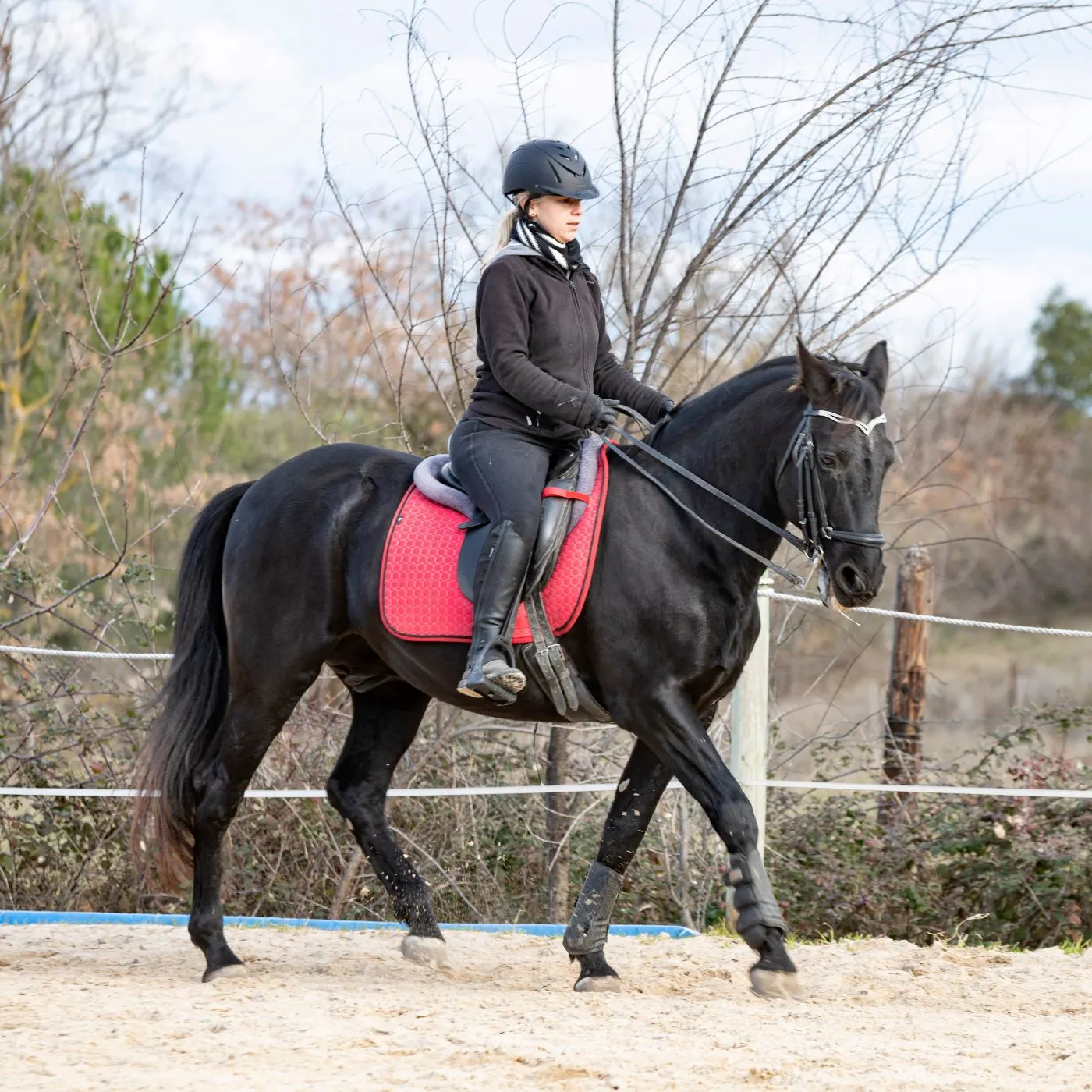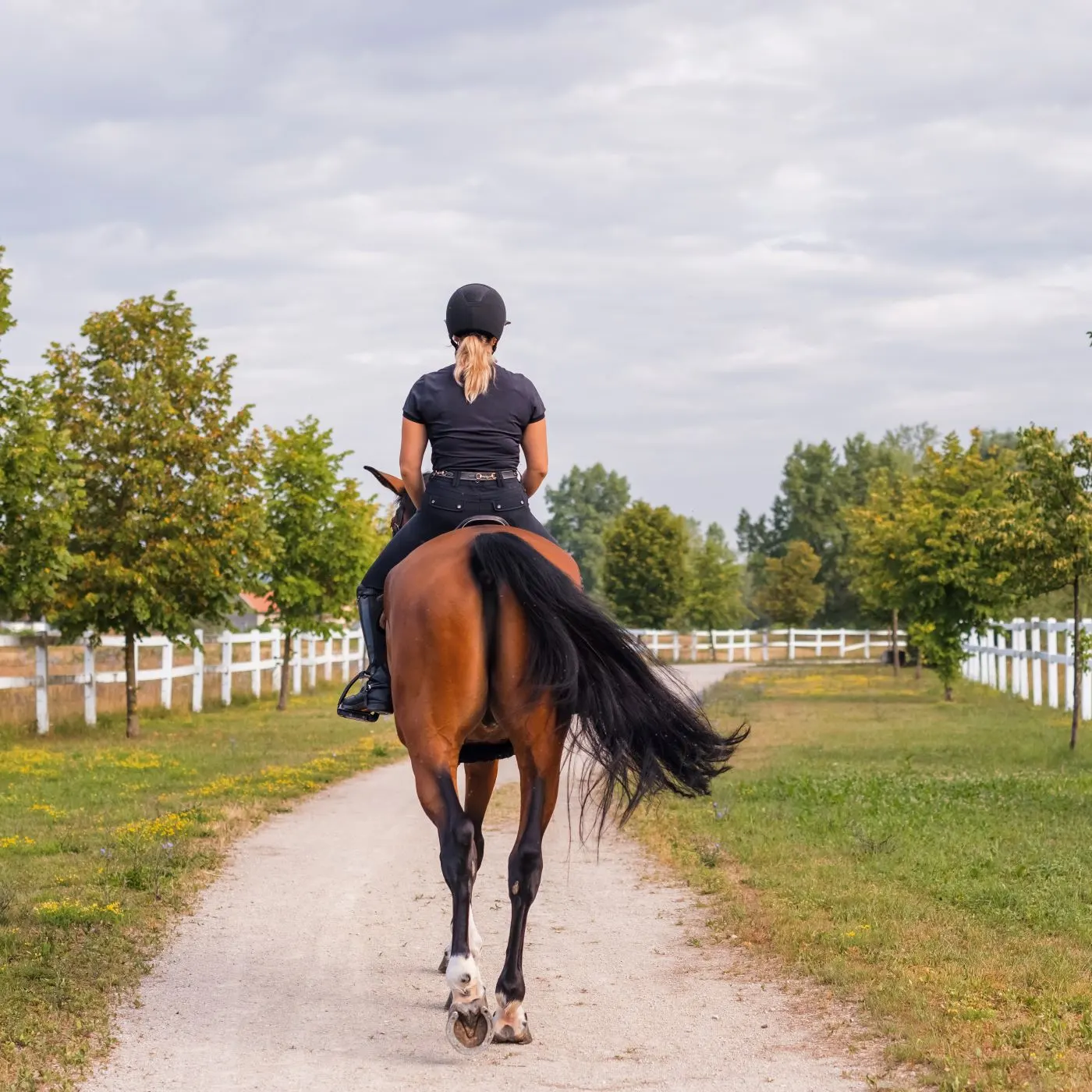Leasing a horse can be a great option for horseback riders who want more access to a horse than riding lessons offer. Leasing a horse is a little like a Costco sample version of what it’s like to own a horse. 😊 You can try on the experience for size, without committing to a huge purchase and responsibility for a horse.
In this article, you’ll learn more about the cost of leasing a horse, how to negotiate, and what to expect as a reasonable price range for a daily, weekly, monthly, or yearly lease.
What you get when you Lease a Horse
First, let’s cover the basics. When you lease a horse, you’re essentially renting from a horse-owner a package.
This “package” includes using the horse, the horse’s training, its riding time, and all its skills. Leasing isn’t usually a favor to the owner (except in certain cases like care leases or partial leases) which work differently from paying for a “full” lease. The money you’ll pay for leasing is a fraction of what the owner spent to acquire, train, and take care of the horse over time. Learn more about the basics of horse leasing and when it’s a good idea.
What it Costs to Lease a Horse
On average, It costs around $300 to $700 to lease a horse each month. Location, training, and the type of lease affect the cost to lease a horse, but this $300-$700 USD figure should include the majority of horses available for full lease.
The going rate for horse leasing varies based on factors like the horse’s skills, the number of riding days, and whether the lease includes access to the horse during high-demand riding times like weekends, summer, and show season.

What You Pay for When You Lease a Horse
Leasing typically covers riding time and access to riding facilities (such as an arena or adjacent trails) but doesn’t include the horse’s medical expenses or farrier costs. Some leases might require the rider (the lessee) to pay these costs, but typically these costs are paid by the horse’s owner (the lessor).
The lease contract should spell out exactly what is and isn’t included in the lease price.
If a horse’s owner seems to avoid committing to specific terms in writing, it’s a good hint that no price is worth the frustration that entering the lease might bring.
A good lease agreement should include:
- Terms of access (i.e. full time or part time? weekends? weekdays? Evenings?
- Restrictions (for example, no jumping, no trail rides off-property, etc),
- and terms of payment (e.g., when the lease fee is due and how it is to be paid).
- Tack usage (does the horse come with a saddle? If not, will you be required to purchase one?)
- Riding schedules
- Permission to take off-property
- Permission to show in horse shows
- Termination (i.e. how much notice must you give to exit the lease? Can you end the lease at any time)
- Handling of vet/farrier care
Types of Horses Leases & How much they cost:
Full Lease: With a full lease, you have complete and exclusive access to the horse. You need to pay a fee each month, usually a horse’s lease price is, annually, about 15-25% of what the horse would sell for. Typically, all expenses and maintenance are your responsibility (which can add up!).
💡 You might also have to pay a commission to the person who helped arrange the lease – this is especially common for show horses.
Partial Lease: In a partial lease, sometimes called a “half lease,” you pay a monthly fee to use the horse on certain days of the week.
With a half lease, your fee won’t cover exclusive rights to the horse, and it might or might not include showing or taking the horse off the property. The details of these agreements vary a lot, and things like commissions, vet costs, and farrier fees can be different. Half leases often cost roughly 1-3% of a horse’s appraised value each month.
Care Lease: This type of horse lease is “free,” however there’s no such thing as a free horse. The lessee in this arrangement is typically responsible for all of the costs associated with caring for the horse, such as boarding, feed, farrier, and vet costs.
| Horse Lease Type | Monthly Cost for a $10,000 Horse | Annual Cost for a $10,000 Horse |
| Full Lease | $350-$750 | $4,200-$8,000 |
| Partial Lease | $150-$500 (varies widely) | $1,800-$5,000 |
| Care Lease | lessee covers horse’s expenses | Varies |
How Horse Leasing Price is Calculated
The main factors that determine a horse’s lease price are location, demand, the value of the horse, and the amenities at the location where the horse lives (if the horse will remain on the property)
- Location and Local Demand: The cost to lease a horse can vary a lot based on where you’re located and whether your local equestrian community has more horses for lease or more riders seeking to lease a horse. In regions with plenty of undeveloped land and a thriving equestrian community, such as Memphis, Houston, or rural Vermont, the cost to lease a horse is usually lower compared to population-dense areas with fewer riders, like Seattle, San Francisco, or New York.
- Breed, Age, and Training Level: The horse’s breed, age, and training level play a big role in determining the cost of leasing a particular horse. Horses registered as an expensive breeds, horses that have advanced training, or horses that have won many horse show ribbons are more expensive to lease.
- Use of the Horse: The intended use of the horse also impacts the lease price. Leasing a horse to use in a few riding lessons each week is usually much more affordable than a lease that permits the lessee to trailer the horse to trail rides or compete in high level horse shows.
- Facility Amenities: The facilities where the horse is stabled can affect the lease cost. Boarding is usually a cost factored into the cost to lease a horse, so leasing a horse that’s living at a high-end stables with top-notch amenities may come at a premium compared to more modest facilities.
- Insurance: Horses worth enough to lease should generally be insured for their value. A horse insurance policy is usually a good investment when multiple parties become involves in the horse’s care.
These factors collectively influence how much you’ll pay to lease a horse and provide valuable insights when negotiating lease terms.

Sample Horse Lease Prices (current summer 2023)
In a recent discussion on reddit’s r/equestrian, 20 horse leasers were surveyed to find what they paid for their horse lease. Here’s a sample of the responses:
- $800/month for a half lease
- $700/mo for a full lease
- $500 for a half lease
- $575 for a half lease
- $900/month for a half lease
- $525 per month for a half lease (Boston area)
- $1600/mo for a full horse lease
- $350 for a partial lease (fancier places)
- $200 a month for two rides a week
- $250 per month for a half lease (DC/MD/VA area)
- $300 – $500 CAD for a half lease (Alberta, Canada)
- $1,000 a month for an east coast USA lease
- $1000/mo for a half lease with one lesson and one trail ride in the NYC area
- $875 per month for a half lease with group lessons
- $250/month for a half lease with self-care responsibilities
- $300/month for a half lease
- $350/month for a half lease
- $200 a month for trail riding in California
- $1200 per month for a half lease with expenses and lease fee
- $250 per month for 3 days a week of riding (Los Angeles area)
Negotiating Your Lease Agreement
Just like purchasing a horse, you have the option to negotiate the price to lease a horse.
Horse leases are flexible agreements, so don’t hesitate to discuss terms with the owner.
If they think you’re a great match for their horse, or they’re actually just desparate for an exercise rider you might get a deal just by asking.
Tips for negotiating the cost to lease a horse
Start by expressing your interest.
Say 2 or 3 things you like about the horse, and 1 or 2 converns you have.
Suggest a monthly fee that is within your budget. For example, say, “I’m interested in leasing your horse. Can we consider a monthly fee around X dollars?”
Negotiating is normal and as long as you don’t suggest a price that’s unreasonable, it’s a great way to get the deal moving.
Where to start negotiating a horse lease price:
Often, deducting about 20-25% off the asking lease cost is a good starting point for negotiations. Expect the horse owner to propose a counteroffer closer to 10-15% discount from their initial lease fee
Horse Lease Costs Broken Down by Term:
How long you lease a horse will have a big impact on the costs you’ll pay:
💰💰💰 Cost to lease a horse for a year
For those passionate about equestrian activities and considering long-term engagements, the cost to lease a horse for an entire year will run approximately $5,000 dollars, though it could be as little as $3,200 or as much as $10,000. An annual lease allows riders to build a consistent relationship with the horse and have frequent riding sessions.
💰 Cost to lease a horse for a day
If you’re planning a special event or a one-time riding experience, leasing a horse for just one day will typically cost around $100 dollars. A short-term lease is perfect for tourists or those looking for a unique outdoor activity. This arrangement is usually referred to as renting a horse and there’s lots more to know about this arrangement.
💰💰 Cost to lease a horse for a month
For individuals seeking an extended riding experience without a year-long commitment, leasing a horse for a month is a great option. The price usually ranges between 500 to 700 dollars. The month-to-month horse lease offers flexibility and a chance to delve deeper into horseback riding.

Red Flags: How to know when leasing a horse is a bad deal
While leasing a horse can offer access to a horse without as much responsibility, not all horse leases are a good deal. In fact, it’s easy to get ripped off when leasing a horse.
Here a some tips to not get ripped off when leasing a horse:
- Check Prices: Talk to local trainers, riding instructors, and breeders to get a sense of the usual cost to lease a horse in your area. This helps you know if the price the horse owner asks is fair.
- Write It Down: Always have a written agreement. A contract helps set clear boundaries and expectations.
- Know the Horse’s Health: Make sure the horse is healthy. Ask for a vet check before leasing, if the horse owner wants you to cover veterinary bills during the lease.
- Try the Horse Out: Before you sign anything. spend some time riding the horse to see if you like it.
- Listen to Your Gut: If something feels wrong, it might be. It’s okay to ask more questions or just say no.
Remember:
Leasing a horse can provide riders the experience of horse ownership without many of the associated costs and responsibilities, such as significant medical bills. However, it’s crucial to recognize that leasing is a service purchased from the horse’s owner, not merely a favor to them. Before deciding, potential lessees should understand and negotiate the lease terms to ensure the arrangement benefits both the rider and the owner.
